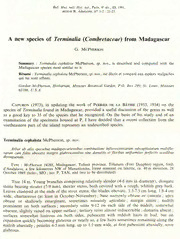
A new species of Terminalia (Combretaceae) from Madagascar PDF
Preview A new species of Terminalia (Combretaceae) from Madagascar
; Mus. e 4 Bull. nail. Hist, nat., Paris, ser., 13, 1991, os section B, Adansonia, n 1-2 21-23. : A new Madagascar species of Terminalia (Combretaceae) from McPherson G. Summary McPherson, and compared Terminalia cephalota sp. nov., described with the is : Madagascan most species similar to it. Resume McPherson, compare aux malgaches Terminalia cephalota sp. nov., est decrit et especes : qui sont lui affines. Box Gordon McPherson, Herbarium, Missouri Botanical Garden, P.O. 299, Louis, Missouri St. 63166, U.S.A. Capuron (1973), in updating the work of Perrier de la Bathie (1953, 1954) on the species of Terminalia found Madagascar, provided a useful discussion of the genus as well in On as a good key to 35 of the species that he recognized. the basis of his study and of an examination of specimens housed have decided that a recent collection from the the at P, I an undescribed southeastern part of the island represents species. McPherson, Terminalia cephalota nov. sp. iarum Arbor scent subcapitatc \flore obovatis integris glab et florihus uniformiter perfi foliis distinguenda Dauphin) Type McPherson Madagascar, Toliara province, Tolariaro (Fort region, foret 14268, : NW m d'Analalava, a few kilometres of Manantenina, forest remnant on laterite, ca. 40 elevation, 28 MO TAN, and two October 1989 to be distributed). (holo-, iso- P, ; mm Tree m. Young branches comprising relatively slender (4-6 in diameter), elongate 14 stems bearing stouter (7-9 mm), shorter stems, both covered with a rough, whitish grey bark. cm cm Leaves ends of the stout stems, the blades obovate, 3.5-7.5 long, 1.8-4 clustered at the October-November) base narrowly obtuse or cuneate apex wide, chartaceous (at least in : ; sometimes minutely apiculate margin entire midrib obtuse or shallowly emarginate, ; ; prominent on both secondary veins 9-12 on each side of the midrib, somewhat surfaces; domatia obscure, on upper surface tertiary veins almost indiscernible absent slightly raised ; ; on somewhat on both pubescent with reddish hairs in bud, but surfaces lustrous sides, few sometimes remaining along expansion becoming glabrous or nearly so, a hairs the quickly mm mm midrib abaxially petioles 4-5 long, up to 1.5 wide, at first pubescent abaxially, soon ; glabrous. 22 Fig. Terminalia flowering branch x an * 4.5; 1. I, 3/4 portion of inflorescence 2, ; x x 3, flower 9 4, longitudinal section of flower x 7 5, adaxial surface of sepal with part of a filament 7. ; ; {McPherson 14268). 23 cm Inflorescences in groups of 3-8 at ends of stout, short stems, 3-5 long peduncles ; cm 2.5-3.5 long, pubescent with whitish, somewhat appressed hairs shorter than those of the mm young leaves clusters of flowers roughly spherical, ca. 12 in diameter, white, comprising ; mm 25-35 flowers. Flowers all perfect, sessile. Bracts ca. long, pubescent, soon caducous. 1 mm Calyx 5-parted, the sepals 2 long, markedly concave, fused about half their length (the and lobes acute, valvate in bud), pubescent abaxially with short, whitish hairs densely much pubescent adaxially with longer, whitish hairs. Corolla absent. Stamens 10, contorted in mm mm bud and on drying, 4-5 long, yellow, the anthers 0.5 long. Disc shallowly 5-lobed, mm Ovary densely long-pubescent. 2-2.5 long, pubescent with short, whitish hairs style ; mm 3-4 long, often curved, yellow, the terminal stigmatic portion scarcely differentiated. Young unknown fruit slightly flattened, pubescent mature fruit (from the probable — ; relationships of this species, the mature fruit can be predicted to be unwinged and terete). Fig. 1. and Terminalia cephalota, because of uniformly perfect flowers, entire leaves, lack its its its Capuron of domatia, would seem belong what called the Fatra group of the genus, leaf to in From and in fact keys out near T. calophylla Tulasne and T. leandriana Perrier of that group. both of these species T. cephalota differs not only in its subcapitate inflorescences, but also in more obtuse leaf apices, larger number of secondary veins, its pubescence distribution, its its Capuron and geography. Tulasne, a species that considered too poorly flavicans T. its known understood be included the main body of his study, nevertheless to resemble the to in is new species in having nearly glabrous leaves and subcapitate (if only 3-8-flowered) From therly made present the new species known from but a single collection in a remnant of the is beleagured eastern coastal forest). LITERATURE CITED — Capuron, R., 1973 (publ. 1974). Contribution a Tetude de la flore forestiere de Madagascar. Notes sur n° Botanique 89-180. Mus. Nat. (Paris), ser 191, genre Terminalia L. Bull. Hist, 3, le 1 1 : — Combretacees de Madagascar des Comores. Ann. Perrier de la Bathie, H., 1953. Revision des et Inst. 1-43. Bot.-Geol. Colon. Marseille, ser. 7, 1 : — Humbert, Madagascar H. Flore de des Combretacees. In et Perrier de la Bathie, H., 1954. : Comores, fam. 151 1-84. :
